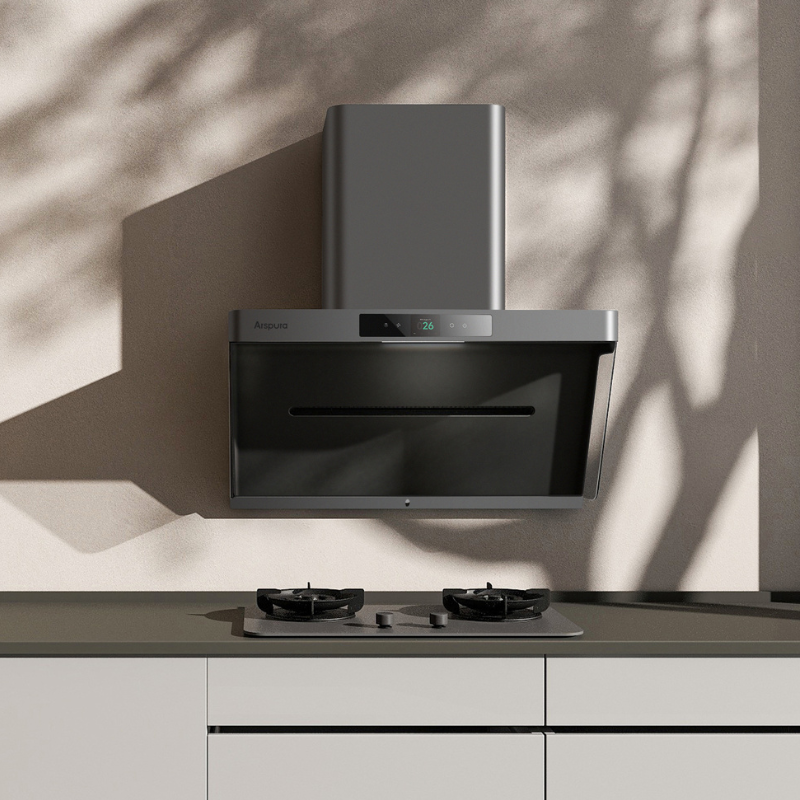Side Suction vs.Top Suction Range Hood: What's the Difference?

Not sure whether to install a side suction or a top suction range hood? This question is asked by many homeowners when they are remodeling their kitchen. Both options help to capture the kitchen air, but they are different in the way they do so. Side vent draws smoke from the side at close range, while the top vent relies on strong upward airflow. Which one works better? Which suits your response and cooking style? To help you make the most informed decisions, we compare the two in terms of pros and cons, as well as the important performance features required for choosing the best range hood for your house.
What is a Side Suction Range Hood?
A side suction range hood or slant vent hood, is a new generation kitchen equipment that collects the smoke and grease at the source of cooking and removes it from the side. Unlike traditional hoods that are placed above the cooktop, side suction hoods are placed next to or slightly above the cooking surface and angled downwards to bring it closer to the fumes.
Ideal for open kitchens, small apartments, and households that frequently cook with high-heat or oily methods like stir-frying, side suction hoods offer effective smoke capture in a compact form.
What are Top Suction Range Hoods?
Top suction range hoods, also called traditional or overhead range hoods, are mounted above the cooktop and draw air upwards through a filter system. These hoods have long been the standard in kitchen ventilation and are available in multiple styles including wall-mounted, island, under-cabinet, and ceiling-mounted designs.
Their operation relies on suction power to pull hot air, smoke, and odors upwards into a duct or recirculating filter system. This design is effective at handling large volumes of smoke and works well in kitchens with high ceilings or professional-style stoves.
Top suction hoods also often include baffle or mesh filters to capture grease, lights to illuminate the cooktop, and variable fan speeds to match different cooking needs.
How Arspura Elevates Side and Top Suction Hoods
At Arspura, we believe kitchen ventilation should do more than remove smoke—it should elevate your entire cooking experience. Whether it’s the side suction P1 or the top suction P2, each model reflects our commitment to cleaner air, smarter design, and effortless operation.
Arspura P1: Side Suction with Precision and Power
The Arspura P1 features patented IQV™ system, engineered to lock in smoke directly at the source. With up to 13 m/s ultra-high airspeed and a 0.03s response time, it captures fumes before they can spread into your kitchen.

Thanks to its side vent design, the intake sits closer to the smoke source, enabling faster and more efficient extraction—especially during high-heat or oily cooking.
Designed without traditional filters and equipped with real-time PM2.5 monitoring, P1 ensures a cleaner cooking environment with less maintenance and more peace of mind. It’s an ideal choice for those who value both performance and minimalist design.
Arspura P2: Intelligent Innovation in Top Suction Form
The Arspura P2, on the other hand, brings our innovation into a refined top suction format. It introduces intelligent upgrades such as negative ion purification, triple safety monitoring (PM2.5, CO, and gas), and a wide glass surface finished with diamond-matte oil resistance for easy cleaning.
As a top suction range hood, P2 keeps the area above the cooktop open—offering more headroom and better flexibility when using tall cookware or managing multiple burners.
Paired with high airflow stability and gesture control, P2 delivers a top-mounted ventilation experience that feels remarkably intuitive, powerful, and modern.

Key Differences Between Side and Top Suction Hoods
The main difference lies in how each type captures smoke and grease during cooking.
Side suction range hoods are installed closer to the cooktop and draw in fumes from the side or at a downward angle. Because the intake is positioned near the pan surface, these hoods can capture smoke and oil particles the moment they’re released. Compared to top suction models, side suction hoods offer faster and more direct extraction. Under similar conditions, they often deliver superior performance—especially during high-heat, oily cooking like stir-frying or deep-frying.
Top suction hoods, on the other hand, are mounted directly above the stove. They rely on smoke naturally rising before pulling it upward through their filters. While effective for general cooking and wider coverage, they may allow fumes to linger briefly before being removed.
If you prioritize immediate smoke control and cleaner air near the cooktop, side suction offers a clear advantage.
Which Performs Better: Side Suction or Top Suction Range Hood?
| Aspect | Side Suction Range Hood | Top Suction Range Hood |
|---|---|---|
| Smoke Capture | Faster, captures smoke right at the source | Slower, relies on smoke rising upward |
| Grease Control | Excellent, especially with filterless / self-separating design | Good, performance depends on filter type and maintenance |
| Noise Level | Lower, shorter air path and closer capture | Higher when running at top speed to pull air from above |
| Cooking Space | Slightly limited above the cooktop | Open, more headroom for tall pots and woks |
| Best For | Stir-frying, oily dishes, compact kitchens | Multi-burner cooking, spacious kitchens |
Side Suction vs. Top Suction: Pros and Cons
Choosing between side and top suction hoods depends on your kitchen layout and how you cook. Side suction hoods offer faster smoke capture and a sleek look, while top suction models provide wider coverage and suit larger cooktops. Weighing the pros and cons helps you find the right balance of performance and practicality.
Advantages of Side Suction Range Hoods
- Closer Smoke Capture: Positioned near the cooktop, side suction hoods capture smoke before it rises, minimizing dispersion and keeping the air cleaner.
- Sleek, Space-Saving Design: Their slim profile makes them ideal for small kitchens or minimalist designs.
- Efficient Oil Separation: Many models feature advanced separation technology that traps grease particles more effectively.
- Low Noise Levels: Since the airflow path is shorter and more directed, noise is often reduced.
- Less Face Contact with Smoke: The lower angle prevents smoke from reaching the user’s face while cooking.

Disadvantages of Side Suction Range Hoods
Tighter Cooking Space: Positioned close to the stove, it slightly reduces vertical space for large cookware.
Installation Height Restrictions: Must be installed at a specific angle and distance from the cooktop for optimal performance.
Design Constraints: May not suit every kitchen aesthetic or cabinetry layout.
Advantages of Top Suction Range Hoods
- Wider Coverage Area: Excellent at capturing smoke from multiple burners, especially in large cooktops.
- Flexible Design Options: Available in many shapes and styles to suit different kitchen layouts.
- Higher Suction Power: Often more powerful in terms of sheer airflow, suitable for heavy-duty cooking.
- Better for Open Kitchens: Effective in removing heat and moisture from the general kitchen environment.
- Maximized Cooking Space: Since the hood is installed overhead, it doesn’t crowd the cooking area, leaving more room around the cooktop for pots, utensils, or head movement.
Disadvantages of Top Suction Range Hoods
Delayed Smoke Capture: Smoke needs to rise before being captured, which may lead to lingering odors.
More Noise: Higher fan power and longer duct paths can create more noise.
Cleaning Challenges: Traditional filters (like mesh or baffle filters) require frequent cleaning.
Grease Buildup: Overhead hoods can allow some smoke to escape and stick to ceilings and walls.
Making the Smartest Choice for Pure Air
No matter which type of hood you choose, the ultimate goal is the same: keeping your kitchen air clean, your walls grease-free, and your home comfortable. Side suction range hoods have rapidly gained popularity in modern kitchens thanks to their superior smoke-locking capabilities and user-friendly design.
For those who prioritize close-range capture and modern features like filterless airflow and PM2.5 monitoring, models like the Arspura P1 stand out. Meanwhile, top suction options such as the Arspura P2 offer spacious overhead clearance with intelligent purification upgrades. The right hood brings lasting comfort and cleaner air to every meal.
